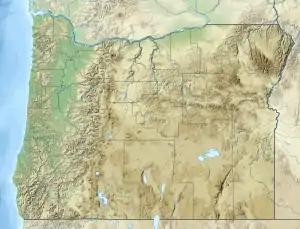Kellogg Creek
Kellogg Creek is a tributary, about 4.5 miles (7.2 km) long,[3] of the Willamette River in the Portland metropolitan area of the U.S. state of Oregon.[1] It begins near Lake Lenore in Johnson City and flows northwest to meet the river at Milwaukie.[1] Kellogg Creek is joined about midway along its course by Mount Scott Creek, its major tributary, which enters the main stem near North Clackamas Central Park.[4]
| Kellogg Creek | |
|---|---|
 Location of the mouth of Kellogg Creek in Oregon | |
| Location | |
| Country | United States |
| State | Oregon |
| County | Clackamas |
| Physical characteristics | |
| Source | near Lake Lenore |
| • location | Johnson City |
| • coordinates | 45°24′05″N 122°34′23″W[1] |
| • elevation | 185 ft (56 m)[2] |
| Mouth | Willamette River |
• location | Milwaukie |
• coordinates | 45°26′30″N 122°38′33″W[1] |
• elevation | 10 ft (3.0 m)[1] |
| Length | 4.5 mi (7.2 km)[3] |
| Basin size | 15 sq mi (39 km2)[4] |
Mount Scott Creek and its tributaries, Phillips and Dean creeks, drain the western flanks of Mount Scott.[4] Kellogg Creek empties into the Willamette River slightly upstream of the mouth of Johnson Creek. This is about 18.5 miles (29.8 km) above the Willamette's confluence with the Columbia River, which in turn flows about another 100 miles (160 km) to the Pacific Ocean at Astoria.[5]
Watershed
Most of the watershed lies inside Clackamas County Service District 1. All of Johnson City as well as parts of Milwaukie and the Oak Lodge Sanitary District are also in the basin. The total area covered by the watershed is about 15 square miles (39 km2).[4] Residential housing, commercial and industrial land such as the shopping mall at Clackamas Town Center, streets and highways such as Interstate 205, and pockets of high-density housing cover parts of the basin.[4]
Several parks, wetlands, and natural areas are scattered about the basin. The upper main stem of Kellogg Creek begins in or near Hearthwood Wetland, a 16.2-acre (6.6 ha) preserve between I-205 and Johnson City.[6] Mount Scott Creek and two of its tributaries, Phillips and Dean creeks, flow through the 89-acre (36 ha) 3-Creeks Natural Area.[7] Happy Valley Park, a 26-acre (11 ha) wetland, feeds Mount Scott Creek.[8] The Minthorn Springs wetland of 6.52 acres (2.64 ha) in Milwaukie drains into lower Kellogg Creek.[9] Mount Scott Creek also flows through Mount Talbert Nature Park and North Clackamas Central Park.[4]
Kellogg Dam
At the mouth of the river is Kellogg Dam, a 16-foot (4.9 m) high structure that creates Kellogg Lake behind it.[10] The City of Milwaukie and its partners plan to remove the dam and do other work to restore runs of Coho and other salmonids that formerly frequented the Kellogg Creek watershed. Dam removal would open up 9 miles (14 km) along the creek and its tributaries for migratory fish.[10] The plan calls for restoration of 14 acres (5.7 ha) of wetlands in the former lakebed.[11] A new bridge over the creek near the mouth is to include bicycle lanes and pedestrian access along Oregon Highway 99E between Kronberg and Riverfront parks in Milwaukie.[12]
See also
References
- "Kellogg Creek". Geographic Names Information System. United States Geological Survey. November 28, 1980. Retrieved January 1, 2014.
- Derived by entering source coordinates in Google Earth.
- Federal Emergency Management Agency (June 17, 2008). "Flood Insurance Study, Volume 3 for Clackamas County, Oregon, and Incorporated Areas" (PDF). City of Lake Oswego. p. 6. Retrieved January 4, 2014.
- Swanson, Andrew J. (October 2010). "2009–2010 Water Quality and Flow Monitoring Report" (PDF). Clackamas County Water Environment Services. pp. 5–6. Archived from the original (PDF) on January 5, 2014. Retrieved January 1, 2014.
- United States Geological Survey. "United States Geological Survey Topographic Map: Lake Oswego quadrant". TopoQuest. Retrieved January 4, 2014.
- "Hearthwood Preserve". The Wetlands Conservancy. Retrieved January 4, 2014.
- "3-Creeks Natural Area". 3-Creeks Organization. Retrieved January 4, 2014.
- "Happy Valley Park". City of Happy Valley. Archived from the original on August 15, 2012. Retrieved January 4, 2014.
- "Minthorn Springs". The Wetlands Conservancy. Retrieved January 4, 2014.
- "Projects: Kellogg Creek Dam, OR". American Rivers. Retrieved January 3, 2014.
- "Kellogg-for-Coho Initiative". City of Milwaukie. Archived from the original on January 5, 2014. Retrieved January 3, 2014.
- "Kellogg-for-Coho Initiative" (PDF). City of Milwaukie. Archived from the original (PDF) on March 4, 2016. Retrieved January 3, 2014.
External links
- Map of the watershed – Clackamas County Service District 1